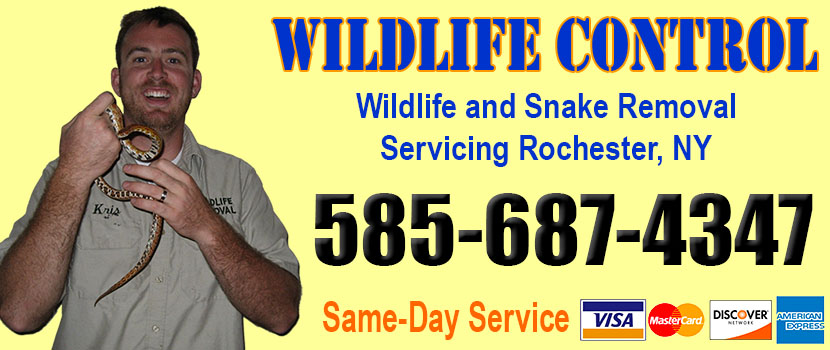
Welcome to rochestersnakes.com! I am David, a snake enthusiast living in Rochester, NY. Many people don't know that Rochester is in fact full of snakes! You just need to know where to find them - they can often be shy and elusive. Some New York snake species are more common outside of the city limits, in different parts of Monroe County NY, but many types of snakes are indeed common in the more urban parts of Rochester. This guide is meant to help educate you about the beautiful snakes of Rochester, and to help you identify the most common snakes of Rochester, as well as the venomous snakes of Rochester that you should learn to recognize and avoid. If you want more detail, click here for my complete list of ALL snake species in Rochester. Remember the following:
- Most snakes of Rochester are harmless and don't want to encounter you
- Venomous snakes exist but are uncommon in Rochester, New York
- Snakes eat rats and mice and are a valuable part of the New York ecosystem
- Never kill a snake - if you leave a snake alone, it will leave you alone.
Common Snake Species in Rochester
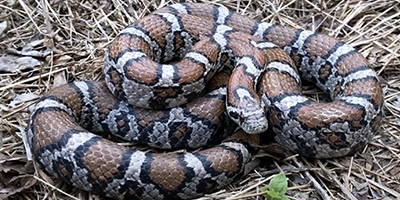 Eastern Milk Snake:
A non-venomous snake found all over the state, they tend to be greyish-tan. A nocturnal constrictor, they are especially fond of rodents. If forced, they will eat other small animals as well. Though their bites aren’t fatal and rarely even break the skin of a person if threatened, milk snakes will vibrate their bodies and bite, possibly as part of their tendency to mimic the venomous coral snake. Not all milk snakes resemble them, however, and despite their aggression, milk snakes aren’t dangerous to people.
Eastern Milk Snake:
A non-venomous snake found all over the state, they tend to be greyish-tan. A nocturnal constrictor, they are especially fond of rodents. If forced, they will eat other small animals as well. Though their bites aren’t fatal and rarely even break the skin of a person if threatened, milk snakes will vibrate their bodies and bite, possibly as part of their tendency to mimic the venomous coral snake. Not all milk snakes resemble them, however, and despite their aggression, milk snakes aren’t dangerous to people.
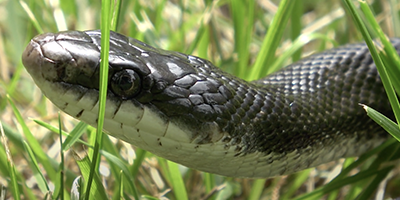 Western Black Rat Snake:
The largest snake in North America, usually four to six feet long, though they can reach lengths of up to eight feet. As befitting their name, these large, black snakes prefer to feed on rodents, though they will eat birds and their eggs if they don’t have a choice. Also a constrictor, their bite is much more painful than a milk snake’s, thanks to their larger size and strength. Not generally aggressive, but like any animal, it will defend itself if agitated. They tend to live in rocky, Cliffside areas within and around the Rochester area.
Western Black Rat Snake:
The largest snake in North America, usually four to six feet long, though they can reach lengths of up to eight feet. As befitting their name, these large, black snakes prefer to feed on rodents, though they will eat birds and their eggs if they don’t have a choice. Also a constrictor, their bite is much more painful than a milk snake’s, thanks to their larger size and strength. Not generally aggressive, but like any animal, it will defend itself if agitated. They tend to live in rocky, Cliffside areas within and around the Rochester area.
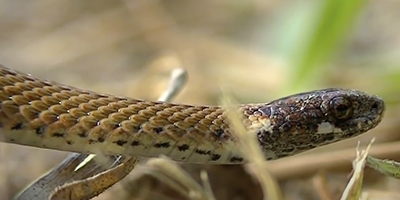 Northern Redbelly:
Another common snake throughout New York, these little ones are less than a foot long. Brown or grey in color, with an orange or red belly, they feed on insect larva, slugs, and worms. About as harmless to humans as a snake can get, really, and in fact, they help people by keeping the slug population in check. For this reason, they can be found in damper areas as well as along green patches. As worms and slugs can be found in moist soil, odds are good redbellies are there as well.
Northern Redbelly:
Another common snake throughout New York, these little ones are less than a foot long. Brown or grey in color, with an orange or red belly, they feed on insect larva, slugs, and worms. About as harmless to humans as a snake can get, really, and in fact, they help people by keeping the slug population in check. For this reason, they can be found in damper areas as well as along green patches. As worms and slugs can be found in moist soil, odds are good redbellies are there as well.
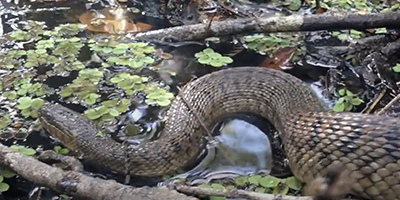 Water Snake:
Found throughout the state where there’s water, these somewhat aggressive snakes are often confused with water-dwelling venomous species. Though not deadly to humans, they can be aggressive, as noted earlier. Their bite is also rather painful. Adults tend to be black while the juveniles are lighter in color, which is common with most snakes. Generally, two to slightly over four feet, their larger size is part of the reason their bite can be so painful. To reiterate, there are not water-based venomous snakes in New York, and two of three venomous species in the state aren’t powerfully toxic to people.
Water Snake:
Found throughout the state where there’s water, these somewhat aggressive snakes are often confused with water-dwelling venomous species. Though not deadly to humans, they can be aggressive, as noted earlier. Their bite is also rather painful. Adults tend to be black while the juveniles are lighter in color, which is common with most snakes. Generally, two to slightly over four feet, their larger size is part of the reason their bite can be so painful. To reiterate, there are not water-based venomous snakes in New York, and two of three venomous species in the state aren’t powerfully toxic to people.
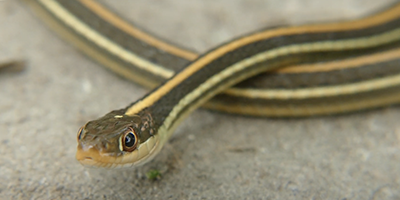 Eastern Ribbon Snake:
These garter snakes are slimmer than average. Garter snakes in general can be found all over the United States. Like water snakes, ribbon snakes are excellent swimmers. Usually two or three feet in length, they are fond of feeding on amphibians, which explains their love of the water. Black with a bright yellow stripe, like others of their species, ribbon snakes, like most garter snakes, are incredibly docile and harmless to people. Also like other garter snakes, if agitated they will release a musk to deter predators.
Eastern Ribbon Snake:
These garter snakes are slimmer than average. Garter snakes in general can be found all over the United States. Like water snakes, ribbon snakes are excellent swimmers. Usually two or three feet in length, they are fond of feeding on amphibians, which explains their love of the water. Black with a bright yellow stripe, like others of their species, ribbon snakes, like most garter snakes, are incredibly docile and harmless to people. Also like other garter snakes, if agitated they will release a musk to deter predators.
Venomous Snake Species in Rochester
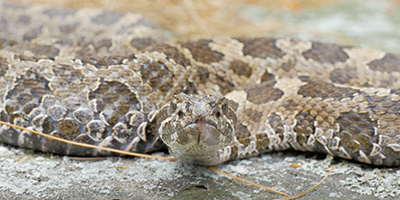 Eastern Massasauga Rattlesnake:
The smallest venomous snake in New York at barely over two feet on average, and one of only three venomous species in the state overall, it’s also the only one near the Rochester area. Fond of damp, swampy lands, they tend to be brownish-grey in color with hourglass spots. Despite their small size, they can be aggressive, and their smaller rattle can make it hard to hear them before it’s too late. Size aside, if bitten seek immediate emergency medical attention. Development and changing climate has taken their toll on these snakes, and they are classified as an endangered species. The other two venomous snakes in New York, the copperhead and timber rattlesnake are not found near the Rochester area.
Eastern Massasauga Rattlesnake:
The smallest venomous snake in New York at barely over two feet on average, and one of only three venomous species in the state overall, it’s also the only one near the Rochester area. Fond of damp, swampy lands, they tend to be brownish-grey in color with hourglass spots. Despite their small size, they can be aggressive, and their smaller rattle can make it hard to hear them before it’s too late. Size aside, if bitten seek immediate emergency medical attention. Development and changing climate has taken their toll on these snakes, and they are classified as an endangered species. The other two venomous snakes in New York, the copperhead and timber rattlesnake are not found near the Rochester area.
If you're unsure, you can email me a photo of the snake at info@rochestersnakes.com and I will email you back with the snake's species. If you found a snake skin, read my Found a Skin? page, and you can email me a photo of the skin, and I'll identify the snake for you. If you need professional Rochester snake removal help, click my Get Help page, or see the below website sponsor I found, who provides that service.
How do snakes smell their environment?
Snakes don't exactly “smell” like we — humans — can smell. The smell of bacon is often enough to lure teenagers from their beds, certain smells having very distinct impressions on the brain, and causing a vast array of reactions.
Snakes have similar reactions, but rather than using a sense of smell, they use their forked tongues to analyze various chemical components in the air around them. Every time the tongue is poked out of the snake’s mouth and then sneaks back in again, it delivers chemical messages that the snake can then analyze with a special gland and system, relaying a wealth of information. The “vomeronasal” system is connected to the “vomeronasal” organ, which is also commonly referred to as the “Jacobson’s" organ. Situated at the top/roof of the snake's mouth, it collects the chemical messages that are picked up via the tongue and then "figures them out”. Electrical signals are believed to be behind it all, essentially allowing the snake to smell life around them in a three-dimensional way. They can use those chemical reactions and messages to work out other animals in the area, and whether or not they are predators or prey. They can figure out where holes are, and whether there are other animals inhabiting those holes. They can determine a lot of things using that smelling-in-3D method, and it is also how female snakes will send out messages to male snakes, letting them know they are ready to breed.
Remember, the term is not poisonous snakes of Rochester, it's venomous snakes of Rochester. Poison is generally something you eat, and venom is injected into you. That said, dangerous snakes are very rare in Rochester. The few venomous snakes of Monroe County are rarely seen. But they are commonly misidentified, so learn about all the snake species of Rochester in order to correctly identify them. These snakes are usually also found in the surrounding towns of Rochester, Webster, Greece, Brockport, Fairport, Penfield, Henrietta, Pittsford, Irondequoit, Brighton, Hilton, Chili, Spencerport, East Rochester, Mendon, Gates, Honeoye Falls, Churchville, Scottsville, Hamlin, Rush, Wheatland, Clarkson, Riga, Gates-North Gates, and the surrounding areas.
Read our article about:
Do snakes chase you?
rochestersnakes.com domain and hosting costs made possible by the generous support of this sponsor:
